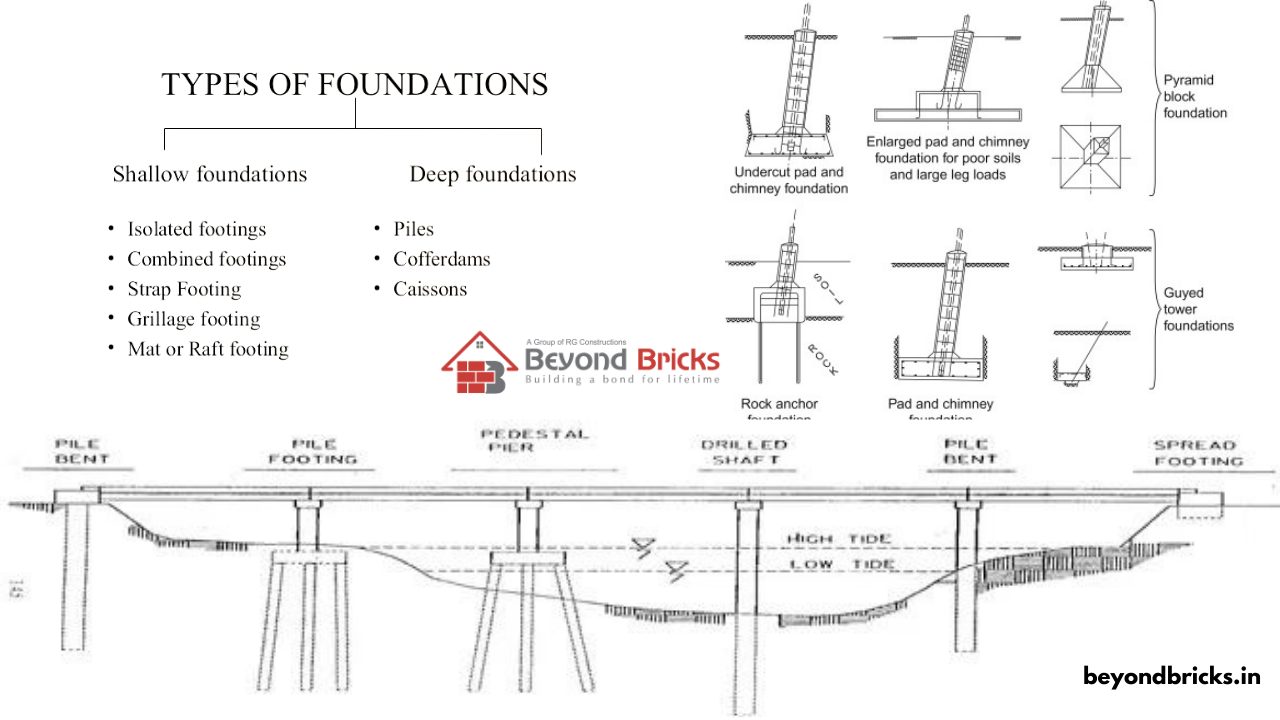To understand the soil's properties and to determine which foundations are best suited for them, soil investigations are performed. This article will discuss the various soil investigations and their reports and the appropriate foundations for different soil types.
Different types of soil investigations for foundation selection
Investigations of Subsurface Soil
Test borings are used to test the soil conditions. These borings can be provided by the soil engineer (geotechnical). Depending on the type of building and site conditions, the number and location of borings will vary. For uniform soil conditions, borings are typically spaced between 100 and 150' apart. However, for more detailed work where soil footings can be closely spaced and soil conditions require borings to be placed 50 feet apart. Boring samples are less required for larger open warehouse spaces with fewer columns (longer span). Borings should extend to firm Strata (go through a suitable foundation soil), and then continue at least 20 feet into bearable soil. On the engineer's plan, the location of borings samples is indicated. These samples are not taken directly beneath the proposed columns. Borings indicate the depth of the soil, its classification according to the unified system, and often the groundwater level. Physical properties: density, moisture content, particle size. The Subsurface Soil Investigation Report recommendation should be based on testing materials obtained from on-site borings.
- Soil's bearing capacity
- Foundation design recommendations
- Paving design recommendations
- Compaction of soil
- lateral strength (active, passive, and coefficient of friction).
- Permeability
- Frost depth
Surface Soil Investigations
For the following cases, surface soil investigations are necessary:
- High water table
- Trouble soils: Peat and soft clay; loose silt; fine water-bearing sands.
- Rock near the surface (requires blasting for excavations).
- Fills or dumps.
- Evidence of subsidence or slides
The indicators above ground of soil conditions are:
- Near Buildings - need shoring, earth, or existing foundations.
- Rock Outcropping is a sign of bedrock. It's good for bearing and frost resistance.
- Water (lakes) - indicates high water table. Foundations must be waterproofed.
- Level Terrain – easy site work, fair bearing but poor drainage
- Gentle Slopes – easy site work and great drainage
- Convex Terrain (Ridge), a dry, solid area to build.
- Concave Terrain (Valley), a wet, soft area to build.
- Steep Terrain is a costly excavation, erosion potential, and sliding soil.
- Some trees have foliage that indicates moist soil. Large trees signify solid ground.
Soil classifications
A simple classification system was created by engineers who deal with soil mechanics. It will allow the engineer to determine the soil's properties. Unified soil classification is based on the identification of soils according to their textural and plasticity characteristics and their grouping about behavior. The soils are often found in nature as mixtures of various sizes of particles. Each component contributes to the soil mixture.
The following criteria are used to classify soil:
- Percentage of gravel, fines, and sand.
- Shape of the grain
Soil's plasticity and compressibility properties
The unified soil classification scheme (uses) gives the soil a descriptive name and a letter symbol indicating its principal characteristics. Visual examination and laboratory testing are used to place solids into their respective groups. The terms cobble gravel, sand, and fines (silt, clay) are used in the unified soil classification to describe the sizes of soil particles. The sizes of soil particles vary from the largest to the smallest.
- Cobbles
- Gravel (Coarse + fine)
- Sand (Coarse + Moderate + Fine)
- Fines made of clay or silt
- Cohesion is the water content and how sticky it is. Internal friction is based on the size of the grains. Triaxial compression testing is used to determine this.
Soil groups:
The soils are then divided into three groups, consisting of:
- Coarse Grained: Divided into gravelly soils, (G), and sands-and sandy soils, (S).
- Fine-Grained - categorized based on their plasticity. (L, H)
- Highly Organic - They are not divided. (Pt)
Coarse Gained is soils that are composed of gravel or sands, and contain a large variety of particles. These soils are best suited for foundations if they are well-drained. These soils have high bearing potential. Particularly the G series (GW GP, GM GC, GP) The percentage of gravel and sand used to identify the soils. Fine-Grained - soils that are Silts or Clays (L.H). These soils contain smaller amounts of clay and silt. These are good for foundations, but they require compaction. The CL is the most suitable series (L). These soils can be identified by their cohesive properties and permeability. High Organic - These soils are often very compressible and not suitable for construction. They are made up of bits of grass, leaves, and branches. This group includes peat, humus, and swamp soils with a highly organic texture. These soils can be identified by their color, texture, or odor. This soil also has a high moisture content. The soil names on the unified soil classification system refer to certain grain sizes and textural characteristics. This is true for coarse-grained soils. The plasticity of the soil is used to name silts or clay. The following information is relevant to samples taken with borings that can be used by the geotechnical engineers in determining foundations:
- For coarse grain soil, the binder's size, mineralogical composition, shape, and character.
- Fine-grained soils: strength, moisture, and plasticity
A visual inspection of soil can be used in construction as a component of the building's design during the initial stages. The classification categories of the unified soil classification system can be used to classify soil. Laboratory testing can be done later. The soil's suitability for foundation building depends on its strength and consolidation.
Solving Soil Problems
A well-drained, free-draining gravel can reduce the problem of soil uplift pressures (GW, GGP). Fine-grained soils made of clays and silts can lead to uplift pressures. This can lead to foundation heaving and the formation of boils. Potential frost damage
- No matter the soil group's frost susceptibility, frost action must occur simultaneously in two situations. First, there must be water. Second, the ground must have sufficient freezing temperatures to penetrate.
- Silts and clays, such as ML, CL, and OL, are more vulnerable to freezing because they contain moisture. Granular soils that are well-drained and not frozen can cause foundation problems.
Drainage Characteristics
- Permeability is a direct indicator of the soil's drainage properties. Moisture in sub-base, base, and sub-grade materials can cause pore water pressure to develop and weaken soils.
- Excellent drainage properties are found in sandy and gravelly soils, with or without fines (GW/GP, SW/SP).
- Poor drainage is a problem for soils with fine grains and soils that are highly organic.
Compaction of Soil
Common equipment for compacting soils is the rubber-tired and sheepsfoot rollers. The sheepsfoot roller has a unique advantage in that it leaves a rougher surface, which allows for better bonding between layers. Granular soils made up of well-graded materials (GW, SW), provide better compaction than poorly graded soils.
Compacting fine-grained soils is also possible
- It is highly recommended that you conduct a field test to determine the compaction characteristics of soil for any construction project of any size.
- The suitability of soils as foundation materials depends on their strength, cohesion, and consolidation. It is determined by the type of structure, load, and how it is used so that soils can be adaptable as a foundation material.
- One type of building might not require soil that is suitable for another.
- Gravel and gravelly soils (GW GP, GM, and GC) are generally good at bearing and consolidating under load.
- Good bearing capacity is also a common property of well-graded sands (SW).
- Poorly graded sands, silty sands (SP and SM), have variable capacities based on density.
- Certain soils that contain silts or clays (ML CL, OL, OL) can liquefy and have poor bearing capacity. They may also settle large loads. CL is the best group for foundations.
- Both organic and highly-organic soils (OL, OH) are low in bearing capacity and often show large settlements under load.
Types of foundations based on soil investigation
It might suffice to use simple spread footings for fine-grained soils with clays and silt. However, this will depend on the load. The position of foundations relative to the soil. It is important to consider foundation walls and hydrostatic pressure.
Alternate methods may be required if the soil is very poor or the structural loads are too heavy. In some cases, where clay soil and fine cohesive silt are present, piling foundations may be necessary. (CH, OH).
Sometimes, it may be economically feasible and desirable to excavate soils that do not have bearing capacity. You can also remove compacted soil and fill in the gaps or import engineered soil. Based on borings, the geotechnical engineer will recommend foundation systems or other solutions.
Beating capacity, minimum depths, special design, or construction methods might also be recommended. The ultimate bearing capacity of soil is divided by a safety factor (usually 2 or 2).
The ultimate bearing capacity refers to the soil's maximum pressure at which it can withstand without settling. The highest safe bearing capacity is found in bedrock. The safe bearing capacity for sand and gravel that has been well-graded is between 3,000 and 12,000 PSF. Silts, clays, and other materials have a lower safe bearing capacity at 1,000 to 4,000 PSF.
Role of foundations
- Transfer the building load to the ground.
- Anchor building to resist wind and seismic loads
- You can isolate your building from frost heaving.
- You can isolate building on expansive soils.
- The accumulation of moisture in the holds.
- Provide living spaces (basement, storage).
- Mechanical systems for houses.
There are three types of foundation configurations: Crawl Space, Basement, and Slab on Grade.
Types of Foundation
Spread Footings
It is suitable for buildings with light loads and/or shallow soils. There are single-spot square pads at columns where bearing walls have an extended form. They are almost always reinforced. These footings carry the load directly to the soils supporting it. The area of spread footing can be obtained by dividing the applied force with the soil's safe bearing capability (f=P/A).
This is suitable for buildings with a low rise (1-4 stories). It requires firm soil conditions capable of supporting the building in the area of the spread footings. Grade beams can be used to connect footings at columns together to increase lateral stability during earthquakes. They are the most common because they are the most affordable.
The footings must be at least three inches below the topsoil and frost line on compacted soil or native soil. Spread footings must be at least one meter above the water table. Concrete spread footings should be at least twice as thick as the stem. The footing must expand as the building's weight increases relative to the bearing capacity and depth of good-bearing soil.
Caissons and Drilled Piers
Drilled caissons (piers), and grade beams are suitable for large soils with high to medium loads or with rocks not too far below. To spread the load, caissons can be either straightened or belled at the bottom. The grade beam is designed for transferring loads to a column foundation by spanning across the piers. Caissons transfer the load to soil with a greater capacity, which is not too far below.
Pile Foundations
Larger soils, or soils that compress with heavy loads. These soils are not suitable for building loads and have a higher capacity than soils deeper below. There are two types: piles
- Friction piles are used in areas where there is no bearing stratum. They rely on the resistance of the pile's skin against the soil.
- End bearing - These transfer directly to soil with good bearing capacity.
The piles' bearing capacity is determined by their structural strength or the soil strength, whichever is lower. Pile materials include wood, steel, reinforced concrete, and cast-in-place concrete piles.
Cast-in-place piles consist of a hole dug in the earth that is then filled with concrete. They are used to carry light loads on soft ground where drilling won't cause collapse. Type of friction, obtained from the shaft perimeter and surrounding soil.
Mat Foundations
For small buildings with light loads, reinforced concrete rafts or mats are suitable for very weak or extensive soils like clays. These mats are often made of post-tensioned concrete. They enable the building to plot on the soil or in it like a raft. It is suitable for buildings between 10 and 20 stories high, where it resists overturning. It is useful where the soil has a large bearing area.
The footing can be spread so that it is more economical to pour one slab (thick), and fewer forms. It can be used as an alternative to driving piles, and it is also less costly and more visible (i.e. It has a smaller impact on the surrounding area than driving piles. Silts are often used on clays with large pores to allow the foundation to settle naturally.
General Summary of Soil Investigations and Types of Foundation
The ranking of soil for foundations (from the best to the least suitable):
- Sand & Gravel – Best
- Medium & Hard Clays - Good
- Silts and Soft Clays - Poor
- Organic Silt and Clays: Undesirable
- Peat - Unsuitable
The higher the PI – Plasticity Index, or Cohesiveness, the more susceptible soils are to shrinkage and swelling. Non-cohesive soils include granular soils made up of gravel and sand. Organic soils can be cohesive, as well as silts and clays. Concrete foundations should have a minimum of 1/4 to 1/2 inch differential settlements. Foundations typically cost 5% of the total construction cost. Spread Footings are the most economical when there is a minimum 3000 PSF safe bearing capacity. Spread Footings are 2 to 3 times more expensive than piles.
Visit our website[Beyond Bricks] to learn more about residential, commercial, and semi-commercial construction.
For Any type of Construction, Beyond Bricks is ready to take over. Check out our packages.





